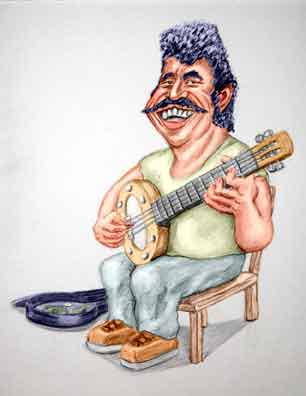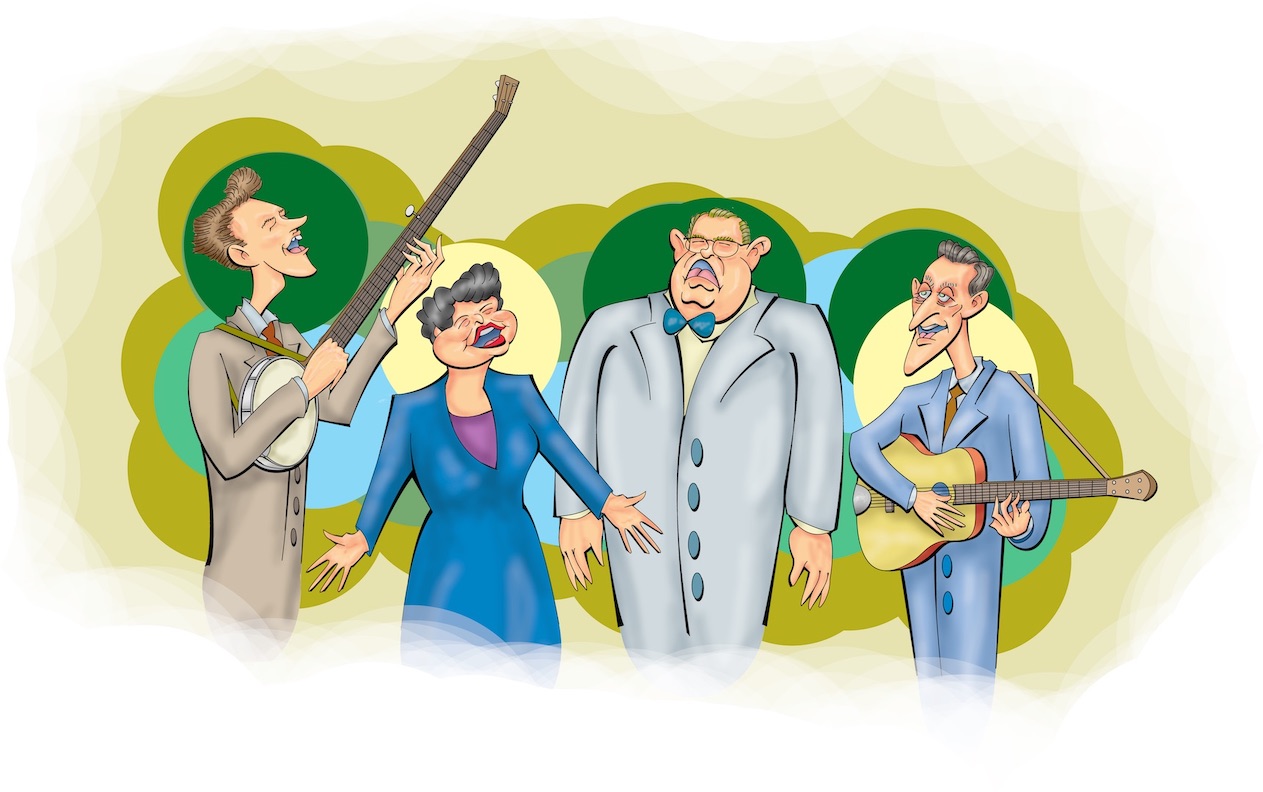Margaret Barry

(Click to zoom in and out.)
Snoopy once said that there aren't more than a dozen world famous grocery clerks. The same could be said of world famous buskers.
But we can think of two. One was Paddy "The Pecker" Dunne whose song "Sullivan's John" has become an Irish folk standard.
The other is Margaret Barry. If you hear someone sing "The Blarney Stone", it's a good bet that their version can be traced back to Margaret.
Both Margaret and Pecker were from the families that in Ireland and England are still sometimes called Tinkers. These are itinerant people who found work doing odd jobs such as mending pots and pans or performing at village fairs and marketplaces. Another common name is Gypsies or more common today, the Travelling1 People.
Footnote
To avoid spittle flinging diatribes from those whose obsession to correct usage and spelling in others is part of their personal therapy program, the use of two "l's" is warranted as this is the usual spelling in England and Ireland. The single "l" is standard in the United States' versions of English. There are Travel(l)ers in America although most residents are not aware of this subculture in their midst.

Pecker Dunne
Famous
Today the word "Gypsies" is considered a derogatory term for the Romani. The Romani are an Indo-European people who retained their nomadic culture over the centuries. But the degree that today's Travellers actually descend from Romani is a complex subject. First, circumstances and preferences sometimes tempt others to adopt a wandering lifestyle. And secondly there has been much intermarriage of the Romani with the local populations - the theme of "Sullivan's John" - and today many Travellers are genetically indistinct from their more sedentary neighbors.
Margaret, although from a family of Travellers, was actually born in a tenement in Cork City in 1917. Her family was quite musical and her maternal grandad was Bob Thompson, one of Ireland's most renown and prize-winning uilleann pipers2. Her dad played banjo and violin for silent movie theaters, and if not in the theaters he played on the streets. When she was a teenager Margaret joined her dad at his busking.
Footnote
The uilleann pipes are a more complex development of the Scottish highland pipes. The bag is inflated by a bellows on the right arm and the notes are played by closing and opening holes on the chanter which is held downward and resting on the player's right knee. Also the drones have keys that sound additional notes and chords generally in a rhythmic manner.
There was a time when an uilleann piper was playing at a booth at a Scottish fair and one of the attendees asked what they were. He replied they were uilleann pipes, "a more sophisticated and civilized form of the Scottish pipes". There were a few dissenting voices on the characterization.
Although you'd think this would be a congenial atmosphere for a musically gifted young girl, Margaret left home at age 16. Her mother had died when Margaret was twelve and there seems to have been some family tensions after her dad remarried to a woman only a couple of years older than Margaret.
She traveled the roads as best as she could and lived the difficult life of the wandering musician. Buskers generally had a circuit and venues were many but not lucrative. She would busk at village markets and fairs, at race tracks, on the streets of the towns, and outside of football stadiums. She would also be asked to play at private functions like parties, weddings, or wakes. None of this brought in much money. In her day-to-day existence, all she hoped for was food and a place to stay.
Margaret's singing was distinctive and powerful and like Pecker, she eventually became a well-know figure around the country. At first she got around by bicycle or bus, but she later traveled in the type of small horse-drawn wagon famously employed by the Travellers. Eventually her wanderings centered around Crossmaglen just across the Northern Ireland border in County Armagh3. It was a good location as it was about halfway between Dublin and Belfast.
Footnote
Tommy Makem, the famous Irish singer who performed with the Clancy Brothers, was from Armagh. Although part of Northern Ireland as defined in the 1922 Treaty with England, it is predominantly Catholic and the population has generally opposed any British presence in their county. When Tommy was introducing a song, he said, "In Armagh where I was born, thanks be to God ..."
Margaret would probably not have branched beyond regional celebrity except that in 1951 Alan Lomax, who had earlier been the director of the United States Library of Congress Folk Song Archives, had been searching out folksongs. His assistant, Robin Roberts, was walking along the street in Dundalk (just south of the border) when she heard the strong sound of Margaret's singing.
Robin quickly went to fetch Alan who set up a recording session with Margaret later that day. To Alan's surprise one of her songs was "Irene" which Alan had first heard in a Louisiana prison performed by the famous African American "songster" Leadbelly. However, there was no mystery here since the previous year the song become the #1 hit in the US when it was recorded by the folk group known as the The Weavers. Margaret said she had learned the song from the radio.
The Weavers
Pete Seeger, Ronnie Gilbert, Lee Hays, and Fred Hellerman
(Click on image to open larger view.)
Alan and Robin's work helped Margaret establish contacts with the British entertainment industry, and Margaret soon appeared on a television show produced by David Attenborough (this was long before he became Sir David). However, her performance wasn't a great success and actually brought in complaints. Not only did the audience object to inviting (gasp!) a Tinker Lady to perform on the sophisticated BBC, but Margaret did not, to put it mildly, fit the mold of the 1950's popular entertainer. To many her voice sounded harsh and her banjo - a rudimentary and inexpensive instrument - did not produce the polished sound that urban audiences expected.
But true folk fans - and we include both established and up-and-coming musicians - recognized that Margaret really could sing. But just like the old Delta blues musicians singing on Fannin Street, Margaret didn't have the luxury of crooning in the bo-bo-bo-bo style of Bing Crosby. She had to belt it out.
But from then on Margaret was a success - not rich, mind you - but at least she was able to get by, particularly when she began performing with Sligo fiddler Michael Gorman. In 1956 she released her first album "Songs of an Irish Tinker Lady". This was the time when the folk music scene really took off and other albums followed. She continued busking but also began appearing at folk festivals and in concerts.
By 1965 Margaret was well enough known to perform at the Newport Folk Festival in the United States. On her tours she met people you wouldn't expect like Frank Sinatra and even the-then-President of the United States, Gerald Ford. True, there's also some people she said she met but probably didn't. There are grave doubts that she really met Elvis Presley at his wedding nor is it believed she knew Robert Mitchum - who she told her grandkids she had married. Margaret could spin as good a tale as any.
By 1970 interest in folk music was waning and Margaret moved with her daughter to Lawrencetown, County Galway (deep in the heart of Ireland). Her public performances dropped considerably although he would sometimes appear on television. She died in 1989, still fairly young by today's standards but given her trials, tribulations, and (we must admit it) her not always healthy lifestyle4, was a fairly ripe old age.
Footnote
Like many of her generation Margaret was a smoker and there is the story that she literally once drank Brendan Behan under the table.
So we wonder. When a major television network decided to make a documentary about Margaret - a documentary we will not name for fear of appearing unduly harsh in criticizing individuals - why was almost all of her singing played as nearly inaudible background music behind an interminable parade of non-stop talking heads? By the end of the show you're ready to bust your gut in frustration because all you've heard of Margaret's actual music are a few notes from a couple of film clips.
Sadly we must conclude that as much as the program praised Margaret, her music, and her influence, someone in the producing hierarchy must have had doubts that today's post-Millineium audience would find much appeal in Margaret's powerful but traditional singing. And regrettably that's probably correct.
But dang it, at least when Margaret sang it was Margaret singing! She never appeared at a televised event and lip-synched her words to a recording - something even some megastars have done such as ...
Well, no names.
References and Further Reading
"Barry, Margaret ('Maggie'), Lawrence White, Dictionary of Irish Dictionary, Cambridge University Press.
"Margaret Barry: Wild Irish Woman of the British Folk Scene", Colin Irwin, The Guardian, January, 18, 2014.
"The 'Irish Tinker Lady' Whose Songs Captivated London", The Irish Times, Angela Byrne, January 16, 2019.
Irish Travellers: The Unsettled Life, Sharon Bohn Gmelch and George Gmelch, Indiana University Press, 2004.
"Margaret Barry Discography", Discogs.
"Pecker Dunne Discography", Discogs.
"XXXXXXXX XXXXX", XXXXXXXXX: XXXXX XXXXXXXXXX XXXXX, Documentary, XXX, XXXX.
